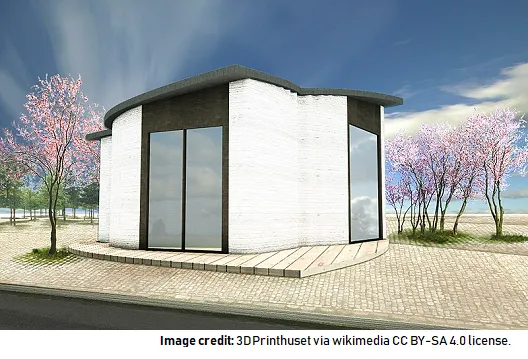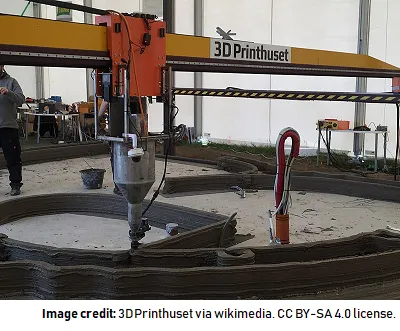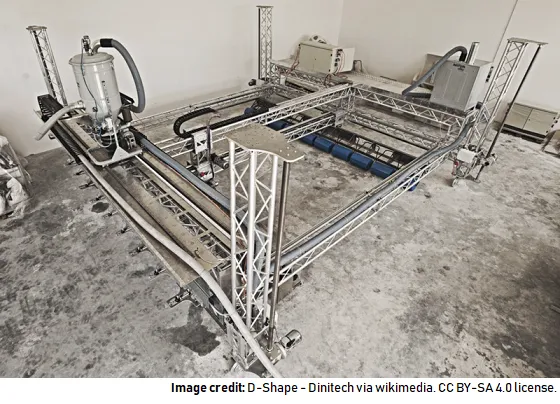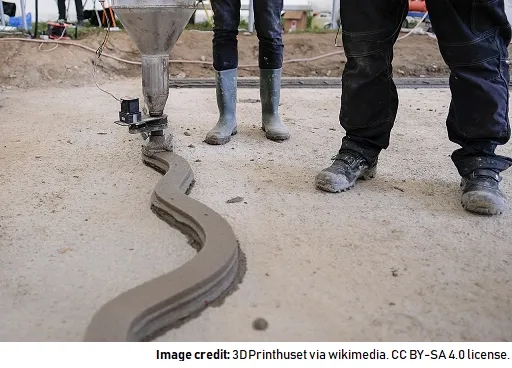
A few months ago I wrote a post about how ugly modern buildings are and the possible reasons why. I also wrote a second post as to why this might be okay.
In that second post I mentioned that maybe with the advent of 3-D printing of buildings we may be able to get the best of both worlds: cheap and beautiful instead of the current mode of cheap and ugly.
So now I want to explore this relatively new world of 3-D home printing in a post.

House Printing
The term 3-D printing of houses takes the idea of 3-D printing of small objects and translates it up to the house scale.
Instead of printing with metal, resins and thermoplastics you are printing instead with quick drying cement and plaster.
There is a printing 'head' that extrudes cement. The printer head moves around in a pattern pre-determined by the architect and the walls and other house structures are built up in an additive manner layer by layer. The cement is quick drying and viscous enough so that it does not flow away. One disadvantage though is that the different layers of cement may dry at different rates and the inter-layer bonding may not be a strong as in traditional concrete casting techniques.

Printing Methods
Rectilinear Framework: This type of printer has a team set up a structure of large metal beams or girders and runners in a large open-air box-like structure. The printing head then scans around the enclosed volume extruding cement and/or plaster from the bottom up and builds the house walls in an additive manner.
Tethered Robot Arm: This type of printer is a single and quite large arm that pivots around a centre point. The printer head is at the end of the arm and moves around its area of influence and also extrudes cement and/or plaster from the bottom up and builds the house walls in a additive manner.
This method has the advantage where the construction team (maybe just one guy) can simply drive up to the site, set up the robot arm and its reference points and then let it start building.
Pre-printed Sectional Housing: In this method smaller sections are printed at a factory and are then trucked out to the job site. A crane at the job site lifts the sections into place which are then joined to each other to build the house up Lego style.
This method has the advantage that you can print your gables and other non-vertical shapes while it is laying on the floor. When the structure dries and hardens the crane then can lift it up, tilting it 90° and voilà you have a sloped cement roof.
Even though this filed has been active for not very many years there are already many more construction techniques than this as well as many unique and interesting completed projects.

The Benefits of Robotic House Printing
Beautiful And More Complex Buildings For Cheap: For me the greatest benefit would be the ability to build unique and beautiful buildings for less expense. I believe that architecture has been in an ugly phase for a long time now and this technique is a light at the end of the tunnel where we can hopefully get both good looking as well as inexpensive buildings.
Faster Construction Times: Why does it take a few months (usually more) to build a house? Because we assemble them piece by piece, either with blocks or bricks or sticks of wood. 3-D printing brings the hope of putting up a house in a day or two (before final fixture fitting of course).
Better Quality Control And Less Waste: How many construction workers are tired, hung-over, drunk and/or stoned on any given day? I would guess a sizeable fraction of them. The rest are not that enthused about their jobs and may not care about the quality of the work they do. With robotic house printing we now get the chance of controlling the build quality to very high and repeatable standards.
Post-Disaster Buildings and Forward-Operating Bases: This new technology has the potential of getting buildings built after a disaster like a hurricane or earthquake in a rapid response fashion. It also has the potential for armed forces around the world to rapidly build solid and shrapnel-resistant buildings at a new base in a quick manner as well. Fly in your cement and several robot printing robots and in a week or two you have a durable army base.
House the Poor: Many articles claim that the great advantage of 3-D printed buildings will be to house the poor and re-vitalize the slums. This is a noble goal but unfortunately I have never seen new technologies ever developed to help the poor first. The direction is always to first charge more to the well-off and then as the economies-of-scale develop the technology becomes available to the less well-off (think cell phones, cars, computers, air travel etc.). This will happen but not in the order many authors claim.
Closing Words
The robotic printing of houses and other structures is exciting and it seems to be developing at a rapid pace. These structures are still relativity rare though but I expect that to change soon.
I, for one, would think it would be neat to simply hang out at a job site for a day and watch an entire house shell get built up and completed before the work shift ends.
Thank you for reading my post.
Post Sources
https://en.wikipedia.org/wiki/Construction_3D_printing
https://en.wikipedia.org/wiki/3D_printing
https://all3dp.com/1/3d-printed-house-homes-buildings-3d-printing-construction/
https://singularityhub.com/2018/03/18/this-3d-printed-house-goes-up-in-a-day-for-under-10000/
http://www.3ders.org/articles/20180213-select-3d-australian-company-developing-3d-printed-plaster-for-interior-design.html
https://www.washingtonpost.com/news/innovations/wp/2015/02/05/yes-that-3d-printed-mansion-is-safe-to-live-in/?utm_term=.24e950074575
https://www.aniwaa.com/house-3d-printer-construction/